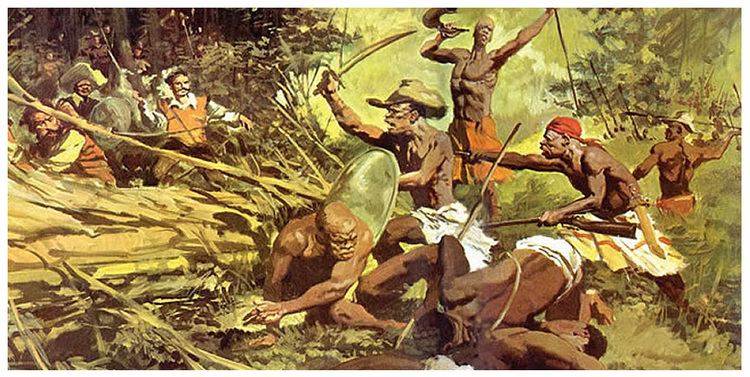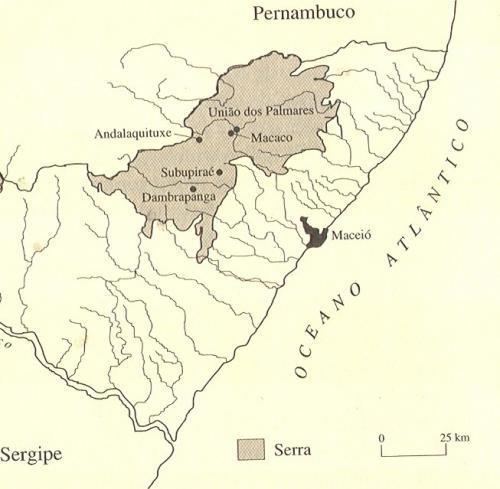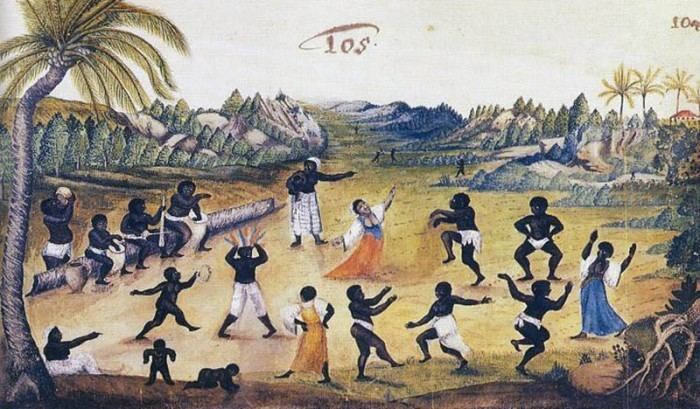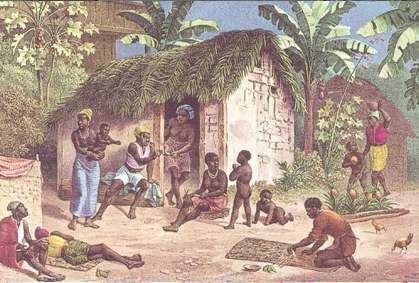Government Monarchy | Founded 1605 | |
 | ||
Religion | ||
Palmares, or Quilombo dos Palmares, was a fugitive community of escaped slaves and others in colonial Brazil that developed from 1605 until its suppression in 1694. It was located in what is today the Brazilian state of Alagoas.
Contents
- Quilombos or mocambos
- Overview
- Formative period 162053
- From Palmares to Angola Janga
- Women in Palmares
- Fighting techniques
- In movies
- References

Quilombos or mocambos

The modern tradition has been to call the settlement the Quilombo of Palmares. Quilombos were settlements mainly of survivors and free-born enslaved African people. The Quilombos came into existence when Africans began arriving in Brazil in the mid-1530s and grew significantly as Slavery expanded.

No contemporary document calls Palmares a quilombo, instead the term mocambo is used. Palmares was home to not only escaped enslaved Africans, but also to mulattos, caboclos, Indians and poor whites, especially Portuguese soldiers trying to escape forced military service.
Overview

One estimate places the population of Palmares in the 1690s at around 20,000 inhabitants, although recent scholarship has questioned whether this figure is exaggerated. Stuart Schwartz places the number at roughly 11,000, noting that it was, regardless, "undoubtedly the largest fugitive community to have existed in Brazil". These inhabitants developed a society and government that derived from a range of Central African sociopolitical models, a reflection of the diverse ethnic origins of its inhabitants. This government was confederate in nature, and was led by an elected chief who allocated landholdings, appointed officials (usually family members), and resided in a type of fortification called Macoco. Six Portuguese expeditions tried to conquer Palmares between 1680 and 1686, but failed. Finally, the governor of the captaincy of Pernambuco, Pedro Almeida, organized an army, under the leadership of the Bandeirantes Domingos Jorge Velho and Bernardo Vieira de Melo, and defeated a palmarista force putting an end to the republic in 1694.
Formative period (1620–53)

Palmares was the general name given by the Portuguese in Pernambuco and Alagoas to the interior districts behind the settlements on the coast, especially the mountain ranges, because there were many palm trees there. As early as 1602, Portuguese settlers complained to the government that their captives were running away into this inaccessible region and building mocambos, or small communities. However, the Portuguese were unable to dislodge these communities, which were probably small and scattered, and so expeditions continued frequently into the interior.

During this time the vast majority of the enslaved Africans who were being brought to Pernambuco were from Portuguese Angola, perhaps as many as 90%, and therefore it is no surprise that tradition, reported as early as 1671 related that its first founders were Angolan. This large number was primarily because the Portuguese used the colony of Angola as a major raiding base, and there was a close relationship between the holders of the contract of Angola, the governors of Angola, and the governors of Pernambuco.
In 1630 the Dutch West India Company sent a fleet to conquer Pernambuco, in the context of the Dutch-Portuguese War, during the period of the Iberian Union. Although they captured and held the city of Recife, they were unable (and generally unwilling) to conquer the rest of the province. As a result, there was a constant low-intensity war between Dutch and Portuguese settlers. During this time thousands of enslaved people escaped and went to the Palmares.
Although initially the Dutch considered making an alliance with Palmares against the Portuguese, peace agreements put them in the position of supporting the sugar plantation economy of Pernambuco. Consequently, the Dutch leader John Maurice of Nassau decided to send expeditions against Palmares. These expeditions also collected intelligence about them, and it is from these accounts that we learn about the organization of Palmares in their time.
By the 1640s, many of the mocambos had consolidated into larger entities ruled by "kings". Dutch descriptions by Kaspar Barlei (Casparus Barleus) (1647) and Johan Nieuhoff (published 1682) spoke of two larger consolidated entities, "Great Palmares" and "Little Palmares". In each of these units there was a large central town that was fortified and held 5,000-6,000 people. The surrounding hills and valleys were filled with many more mocambos of 50 to 100 people. A description of the visit of Johan Blaer to one of the larger mocambos in 1645 (which had been abandoned) revealed that there were 220 buildings in the community, a church, four smithies, and a council house. Churches were common in Palmares partly because Angolans were frequently Christianized, either from the Portuguese colony or from the Kingdom of Kongo, which was a Christianized country at that time. Others had been converted to Christianity while enslaved. According to the Dutch, they used a local person who knew something of the church as a priest, though they did not think he practiced the religion in its usual form.
From Palmares to Angola Janga
After 1654 the Dutch were expelled, and the Portuguese began organizing expeditions against the mocambos of Palmares. In the post-Iberian Union period (after 1640), the kingdoms of Palmares grew and became even more consolidated. Two descriptions, one an anonymous account called "Relação das Guerras de Palmares" (1678) (Account of the war of Palmares), the other written by Manuel Injosa (1677), describe a large consolidated entity with nine major settlements and many smaller ones. Slightly later accounts tell us that the kingdom was named "Angola Janga" which according to the Portuguese meant "Little Angola," although this is not a direct translation from a Kimbundu term as one might expect. The two texts agree that it was ruled by a king, which the "Relação das Guerras" named "Ganga Zumba" and that members of his family ruled other settlements, suggesting an incipient royal family. He also had officials and judges as well as a more or less standing army.
Although the "Guerra de Palmares" consistently calls the king Ganga Zumba, and translates his name as "Great Lord" other documents, including a letter addressed to the king written in 1678 refer to him as "Ganazumba" (which is consistent with a Kimbundu term ngana meaning "lord"). One other official, Gana Zona also had this element in his name.
After a particularly devastating attack by the captain Fernão Carrilho in 1676-7, Gana Zumba sent a letter to the Governor of Pernambuco asking for a peace. The governor responded by agreeing to pardon Gana Zumba and all his followers, on condition that they move to a position closer to the Portuguese settlements and return all enslaved Africans that had not been born in Palmares. Although Gana Zumba agreed to the terms, one of his more powerful leaders, Zumbi refused to accept the terms. According to a deposition made in 1692 by a Portuguese priest, Zumbi was born in Palmares in 1655, but was captured by Portuguese forces in a raid while still an infant. He was raised by the priest, and taught to read and write Portuguese and Latin. At the age of 15, however, Zumbi escaped and returned to Palmares. There he quickly won a reputation for military skill and bravery and was promoted to the leader of a large mocambo.
In a short time, Zumbi had organized a rebellion against Gana Zumba, who was styled as his uncle, and poisoned him (though this is not proven, and many believe Zumba poisoned himself as a warning not to trust the Portuguese). It is argued that Zumba was sick of fighting, but even more weary of signing the deal with the Portuguese, foreseeing their betrayal, and renewed war. By 1679 the Portuguese were again sending military expeditions against Zumbi. Meanwhile, the sugar planters reneged on the agreement and re-enslaved many of Gana Zumba's followers who had moved to the position closer to the coast.
From 1680 to 1694, the Portuguese and Zumbi, now the new king of Angola Janga, waged an almost constant war of greater or lesser violence. The Portuguese government finally brought in the famed Portuguese military commanders Domingos Jorge Velho and Bernardo Vieira de Melo, who had made their reputation fighting Native American peoples in São Paulo and then in the São Francisco valley. The final assault against Palmares occurred in January 1694. Cerca do Macaco, the main settlement, fell; and Zumbi was wounded. He eluded the Portuguese, but was betrayed, finally captured, and beheaded on November 20, 1695.
Zumbi's brother continued resistance, but Palmares was ultimately destroyed, and Velho and his followers were given land grants in the territory of Angola Janga, which they occupied as a means of keeping the kingdom from being reconstituted. Palmares had been destroyed by a large army of Indians under the command of white and caboclo (white/Indian mixed-bloods) captains-of-war.
Although the kingdom was destroyed the Palmares region continued to host many smaller runaway settlements, and so the Portuguese still had the problems they had before, but there was no longer the centralized state in the mountains.
Women in Palmares
The overwhelming majority of enslaved people in the Portuguese colonies were male. This majority was also seen in the quilombos. For this reason Palmaristas were often sent on raiding missions in order to procure female citizens.
The smaller female population, and perhaps Amerindian cultural mores, gave rise to a system of polyandry. These polygamous wives ran their household and designated tasks for their husbands. The central importance of females in the quilombos stands in stark contrast to the patriarchal society experienced in the coastal colonies by their Portuguese counterparts.
Fighting techniques
Although it is often argued that the inhabitants of Palmares defended themselves using the martial art form called capoeira, there is no documentary evidence that the residents of Palmares actually used this method of fighting, which historian Thomas Desh-Obi has connected with the Benguela Highlands region of Angola. Most accounts describe them as armed with bows, arrows and guns. They were able to acquire guns by trading with the Portuguese and by allowing small-holding cattle raisers to use their land.
The inhabitants of the larger towns typically protected them with elaborate fortifications, including walls and palisades, pit traps and trenches. However, often the inhabitants abandoned and burned their towns when sizable Portuguese armies approached, melting away into the woods and mountains. Hence even the most successful Portuguese expeditions rarely captured more than a few hundred people. Zumbi's determined defense of his capital against the Portuguese, who brought up artillery to assist in the attack, was unusual.
In movies
A semi-fictional account of Palmares was made into the 1984 Brazilian film by Carlos Diegues, Quilombo.
